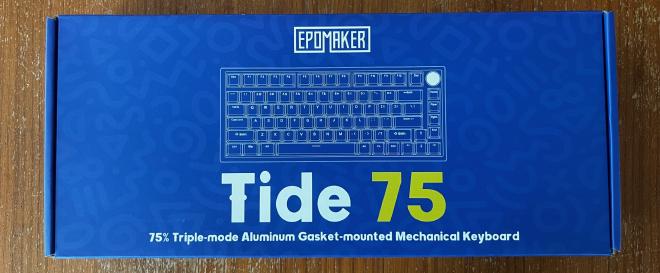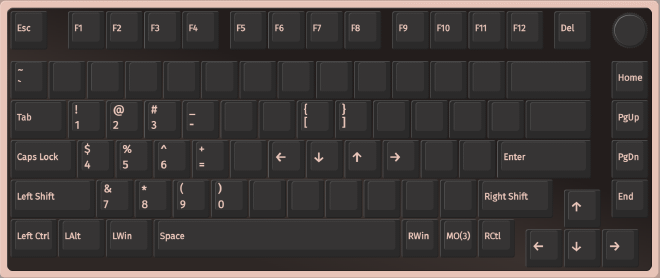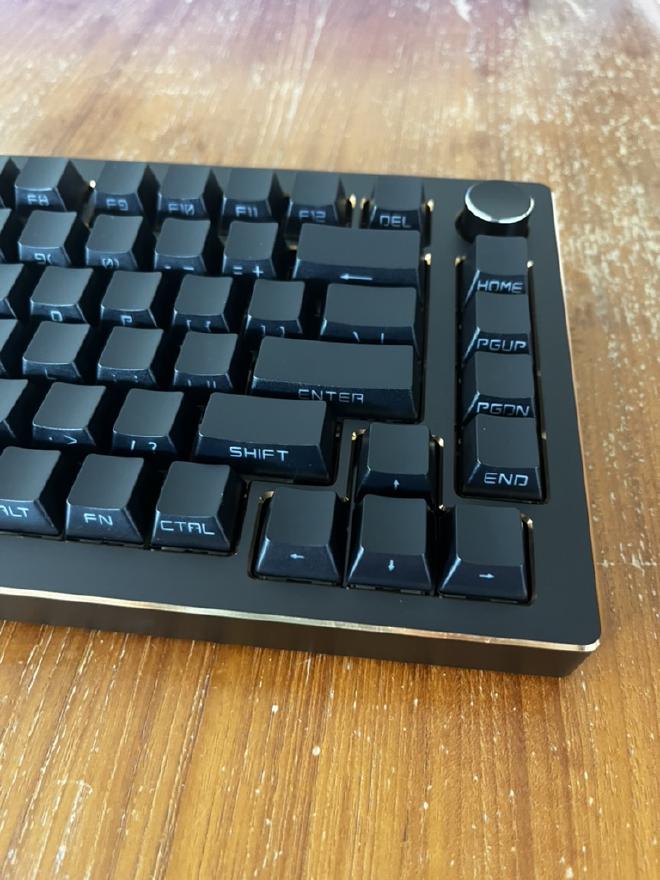You know that feeling when you are trying not to buy new mechanical keyboards and still one manages to find its way to your desk? Well, that’s precisely how I felt last week when a package from Epomaker arrived! For about a fortnight, I’ve been putting the Tide75 to the test, let me tell you what I found!

Disclaimer: Epomaker contacted me to write this review as an exchange for keeping the keyboard. They didn’t have a say on what I wrote, except for the two links to their web and Amazon shop.
First Impressions#



The first thing I noticed is the weight of this keyboard, it is thick! Immediately then, I knew this was a solid product (pun intended 🥁). The sound is a delight. And overall, it is a very good-looking keyboard. On the other hand, the knob feels a bit loose, and I’m not a fan of the font type they used for the caps.
But let’s not judge this book only by the cover! I spent almost two weeks with it as my daily driver to find out if this one is a keeper. My main interest in such a device is to write code and prose, so sorry gamers, I don’t have much for you. Here are the 4 areas which I assessed this keyboard on:
- Comfort with extended use
- Base functionality. I don’t want to be interrupted while I’m working because something is not connecting properly or other similar issues
- Extra customizations. Being able to adapt the keyboard to my needs is a great plus for me
- Aesthetics. I will be looking at this piece of equipment for at least 8 hours every day
Comfort#
The distribution of the keys is superb. I have small hands, but it doesn’t feel like an effort to do any key combination. I’ve experienced RSI in the past, and I will invest in a good keyboard rather than experience pain. I spend hours at a time typing, and so far, I haven’t felt any discomfort with the Tide75.
As a macOS user, the main issue I have with the layout is that it is missing the Cmd key on the right. Thankfully, this can be customized (more on this later)!
I really enjoy how the keyboard will not move a millimeter while I’m typing. I compared this to my Reform keyboard, which is the closest one in size I have, and the Epomaker Tide75 is significantly better. This boy is so heavy that even my DasKeyboard 4 Professional, which is a full-sized keyboard, couldn’t compete. Now this, of course, is a double-sided sword because it means I would never consider carrying it around in a backpack.
One thing I still have to get used to, is the minimum touch the keys require to react, but I like it, it just means I have to change some old bad habits, like resting my thumb on the space bar.
As for the sound, I’m a big fan of loud keyboards (Cherry MX Blue Switches), but you cannot take such a keyboard to an office unless you want to become an outcast, this is why, on my daily drivers I have (Cherry MX Silent Red Switches) with dampers. The sound of the Epomaker Lemon Switch, sits somewhere in between these two, which I would recommend for a single person office, or one that is ok with this level of noise. I tried putting dampers on the keycaps, but it didn’t really have an effect.
Functionality#
The keyboard can be connected using a cable, a dongle, or via Bluetooth. When connected via cable, the keyboard also charges the 4000mAh battery. I attest to the quality of the charge since I had to use the cable during the different times that I configured the keyboard, I’ll make sure to report that in a later update.
Connecting with the dongle worked like a charm. The only complaint I have is that the little housing where it stays put feels a bit loose, maybe it’s not so bad but for me, it’s another reason not to put it inside a bag pack.


Connecting via Bluetooth is super simple. You have 3 presets when pressing Fn + Q/W/R. Switching between them works just fine, and the right preset wakes up my computer as expected. This was very handy since I have multiple devices on my desk and I could switch between them without having to move around the desk as I used to.
At some point when testing, I started experiencing disconnections, and it turned out to be caused by low battery. A battery indicator could be a great addition. It could even be done with the existing RGB LEDs, I think that would be pretty sick!
Media keys for macOS can be accessed with the Fn + digit, they are even in the same position as the Apple keyboard, which is a great design choice so you don’t have to learn a new layout. The only minor issue I found was in the manual where it says that Fn + S is Mac mode and Fn + A is Win mode, but for me is the other way around (at least for mac, I don’t have a Windows machine to test).
Customizations#
If I have a keyboard that is comfortable and the basic functionality fits my needs, then I can be happy with it, but being able to customize it, is what can make it a joy to type with a certain keyboard.
The manual says I can configure the layout by downloading an app from this repository, and there is a homebrew formula for it too. Unfortunately, I wasn’t able to make it work. The app loads, but it never finds the keyboard. Thankfully, the online version did work. In addition to this app, you also need to download the keyboard’s definition file. The link on the manual doesn’t work, but this one does.
Ok, with everything ready, you can go to the “design” tab and, unlike me, make sure to turn OFF “Use V2 definitions (deprecated)” despite it being a step in the manual 🤦♂️. Hit the load button, and select the definition file. If things work correctly, you will see the keyboard’s layout on the page. I have the “Long Spaces” version, which is nice, but the “Split Spaces” must be better in my opinion. Now you can move to the “configure” tab, and you should see the layout with all key definitions.


All changes you do to the keyboard, take effect in real time, which is pretty cool for playing with the RGB colors and such configurations. For configuring the layout, I’m still not sure if I like it because I like to make all my changes and change them at once. But it’s just a different way of working, and maybe I won’t even notice it after using it a couple of times.
There are 5 customizable layouts, which means lots of room for making this keyboard your own. For now, I will customize the default layer to have the right Cmd key, and layer 2 for having easier access to the arrow keys on the hjkl keys (yes, Vim has messed up this bad with my head 🙈) and the numbers. This is what it looks like:

If you like my setup, then feel free to grab it and play with it
Aesthetics#
Overall, I think the keyboard looks great. The black pitch of the aluminum mixed with the copper borders and the RGB LEDs on look fantastic! Even the bottom of the keyboard looks pretty nice. This is a product that you enjoy touching, I get a similar vibe when interacting with my MNT Reform 2 Laptop.


There is just one mistake Epomaker made here. The knob border is platinized, which in my opinion doesn’t mix well with the copper. I’m also not a fan of the type used, for most letters it is ok, but 4$ reads more like 45. Words like PGDN give the impression that the painting went wrong, but it’s just the font type they chose for it. Not a deal-breaker, but hopefully Epomaker will move away from this font in the future, check the difference with the font used in the MNT Keyboard, which is such a delight to read.

Size Comparison#



Pricing#
The Epomaker Tide75 has a $139.99 price tag, plus taxes. Since I didn’t pay for it, I asked ChatGPT to calculate it for me, and it thinks it would be an extra 26.65 EUR for taxes, making it a total of approximately 153 EUR.
Deciding whether a piece of equipment is worth buying is for you to decide, but compared to these other devices, the price seems just about right to me:
- Magic keyboard is 149 EUR. It comes with the T chip, but it doesn’t have the mechanical keyboard experience, replaceable switches, and neither the extensible configuration.
- DasKeyboard Pro is 179 EUR. It is a mechanical keyboard including the Numpad, but lacks RGB, replaceable switches and it’s not configurable.
- Vortex Core is 99 EUR. It comes with the RGBs, and it is configurable, but it’s only a 40% which might be challenging to adapt for many people.
Conclusion#
Overall, I think this is a great product and anyone looking for a mechanical keyboard will not be disappointed. It happens to be that my daily driver, the Ergodox EZ just broke a few months back, and the Tide75 will take its place as my number 1.
The issues I have with the keyboard are minor, but in my opinion, could take the Epomaker from a good choice, to a great one. Having an up-to-date manual, including extra blank keycaps for customization and most important, choosing a more readable font and matching the knob color with the rest of the keyboard.
Thanks Epomaker for this remarkable gift, I hope that they feel proud to see their little boy is helping build open-source.
The following links were given to me by Epomaker. I don’t make any commission on them. If you’d rather not use them, type Epomaker Tide75 in your preferred search engine, and you should find them, but you might get a different product than the one I reviewed here.
Interested in grabbing yours? Check out the Epomaker Online Store, or the Epomaker Amazon Store.
Reply by Email